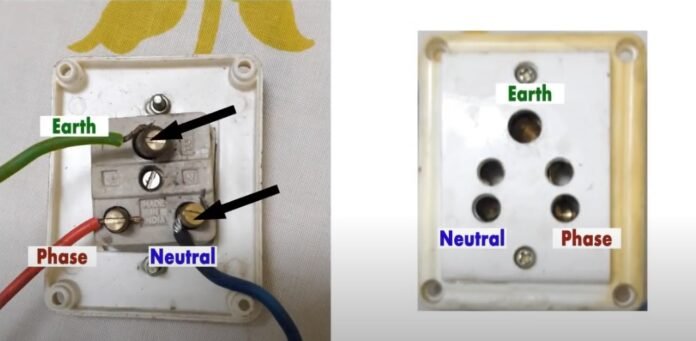Earth is related to ground which is used for safety concerns against leakage or residual currents in the system.
Earth and neutral are related concepts in electrical systems.
Earth refers to the process of connecting a conductive object, such as a metal conduit or electrical equipment, to the ground to ensure that it is at the same potential as the earth. the earth is considered a safe reference voltage and provides a safe path for electrical currents to flow in the event of a fault.
Neutral, on the other hand, refers to a conductor in an electrical system that is connected to the earth and serves as a reference point for other voltage levels in the system. the neutral conductor is used to balance the electrical load in a circuit and ensure that the voltage is zero at the neutral point.
In other words, the neutral conductor provides a return path for electrical currents that flow through the circuit.
What is Earth
An Earth which is also known as ground is a safety connection which is used to protect the electrical appliances from the electric shock.
In electricity, earth refers to the ground or the surface of the planet we live on, which is used as a reference for electrical potential in electrical systems. the earth is considered a safe reference voltage and is used as a means of providing a path for electrical currents to flow in the event of a fault or malfunction in the system. this helps to reduce the risk of electrical shock or damage to equipment.
Earthing is an important safety measure in electrical engineering and is commonly used in homes, buildings, and electrical installations.
What is Neutral
Neutral refers to a conductor in an electrical system that is connected to the earth and serves as a reference point for other voltage levels in the circuit.
The neutral conductor is used to balance the electrical load in a circuit and ensure that the voltage is zero at the neutral point.
In other words, the neutral conductor provides a return path for electrical currents that flow through the circuit. the neutral conductor is often connected to the earth through a process known as earthing.
In summary, the neutral conductor in an electrical system serves as a reference point for voltage levels and provides a return path for electrical currents, helping to balance the electrical load and ensure a safe reference voltage.
Difference Between Earth and Neutral
Earth and Neutral are two different electrical terms:
Earth: refers to a conducting connection between an electrical system and the earth. Earthing provide a safety path for electric current to flow.
Neutral: refers to a conductor in an electrical power distribution system that is intended to carry current under normal operating conditions
The purpose of neutral is to ensure the electrical distribution system has a balanced load, providing a return path for the flow of current in a circuit.
| Difference Between Earth and neutral | |
|---|---|
| Earth | Neutral |
| Earth is least resistance path which is used for safety purpose | The neutral conductor provides a return path for electrical currents that flow through the circuit |
| Earth wire can be used as neutral | It can be turn into earth |
| Earth is surging point of electric appliances | It is the return path of electric supply |
| Earth wire have very little current | Neutral wire not have any current |
Role of Earth Wire in Circuit
The earth wire, also known as a ground wire, plays an important role in electrical safety.
It provides a direct path for electrical current to flow to the ground in the event of a fault or electrical surge. this helps to prevent electrical shock and protects electrical equipment from damage. additionally, it helps to balance the electrical current in a circuit, ensuring that it operates correctly and efficiently.
Role of Neutral Wire in Circuit
The neutral wire in an electrical circuit carries the return current from electrical loads back to the source, such as a transformer or generator.
This wire helps to complete the circuit and allows electrical energy to flow to the load and then back to the source. the neutral wire is typically connected to earth at the source, and its purpose is to provide a safe path for the return current, preventing any electrical shock or damage to the electrical equipment.
The neutral wire also helps to maintain the correct voltage level in a circuit, ensuring that it operates correctly and efficiently.
Recommended Articles:
Difference Between Density And Volume
Difference Between Diffraction And Interference
Difference Between Diode And Rectifier
Difference Between Discovery And Invention
Difference Between Distance And Displacement
Earthing refers to the process of connecting a conductive object, such as a metal rod, wire, or plate, to the ground. this is typically done for safety and electrical reasons, as it provides a direct path for electrical current. Earthing can also help to reduce the risk of fire and provide a stable reference voltage for electrical systems Neutral refers to a conductor in an electrical system which is used to balance the electrical load in a circuit and ensure that the voltage is zero at the neutral point. The neutral conductor provides a return path for electrical currents that flow through the circuit. Copper is commonly used to make earth wire. Earth refers to a conducting connection between an electrical system and the earth. Earthing provide a safe path for electric current to flow. Neutral is used to balance the electrical load in a circuit and ensure that the voltage is zero at the neutral point. Vegetables Names FAQs
What is Earthing?
What is Neutral?
Which metal is used to make earth wire?
Write the point of difference between earth and neutral?
